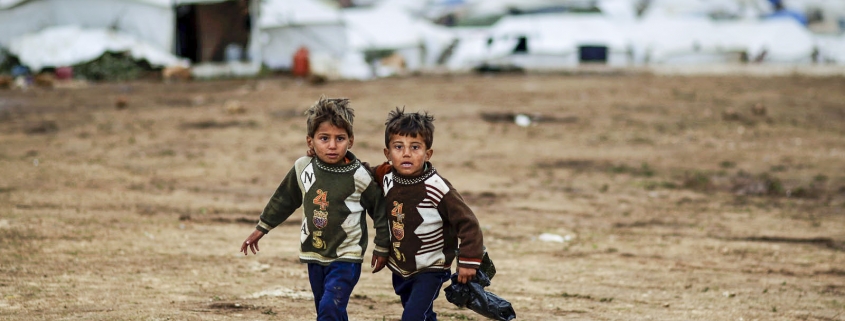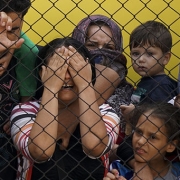Chronicle of Humanitarian Suffering: A Historic record of forced displacements in 2015
For the first time in human history, forced displacements had hit the record of people who were forced to flee their home due to unresolved crises. The UN Refugee Agency warned that one out of every 122 persons on Earth is being forced in involuntary relocation (UNHCR, 2015b).
The last five to six years, at least 15 old and new conflicts have emerged including conflicts, persecutions, violence and violations of human rights. Reaching 60 million, the victims of these displacements can be distinguished in three main groups: refugees, asylum seekers and internally displaced persons (IDPs).
With the global trend of displacements constantly acceding, the conflict in Syria constitutes the main source of refugees and IDPs amassing more than 4.2 million by mid-2015. Furthermore, other armed conflicts in Afghanistan, Burundi, Mali, Somalia, South Sudan, Ukraine and the Democratic Republic of the Congo have contributed in the significant increase of the refugee numbers by 5% from the end of 2011 to mid-2015. After Syria, Afghanistan represents the second-largest source of refugees (2.6 million). Next follow Somalia (1.1 million), South Sudan (nearly 750,000), and Sudan (640,900). Accordingly, the Democratic Republic of Congo (535,300), the Central African Republic (470, 600), Myanmar (458,400), Eritrea (383,000) and Iraq (377,000) shape the top 10 of world’s refugee populations for mid-2015. All data presented above is based on UNHCR¹ report “Mid-Year Trends 2015“.
Asylum-seekers and refugees under international law
According to the international law (1951 Convention and 1967 Protocol relating to the Status of Refugees), states are obliged to provide protection to refugees and stateless people. As refugees are defined “all persons outside their country of origin for reasons of feared persecution, conflict, generalised violence or other circumstances that have seriously disturbed public order and who, as a result, require international protection” (UNHCR, 2013).
Respectively, the term of asylum seekers ”can either refer to an individual whose refugee status has not yet been determined by the authorities but whose claim to international protection entitles him or her to a certain protective status on the basis that he or she could be a refugee or to persons forming part of large scale influxes of mixed groups in a situation where individual refugee status determination is impractical” (UNHCR, 2013).
Refugees looking for a shelter in host countries
According to the UNHCR’s press release for the first half of 2015, Turkey hosts the biggest wave of refugees. Lebanon follows with the biggest proportion of refugees to its population size, while Nigeria comes third in place with its economy burdened by the cost of sustenance for refugees.
In Europe, the land of promise and prosperity, refugees are in search of safety and a better quality of life. Many of them attempt to enter the European territory through the Mediterranean Sea by putting their life at huge risk. Thus, sea arrivals have seen a sharp rise between 2014 and 2015, followed by a parallel increase in the numbers of dead/missing persons. For the first quarter of 2016, arrivals by sea have reached the 164,338 (Source: UNHCR – Regional Overview, 2016b). As for the host countries, Germany has accepted the biggest number of asylum-seeks for the first half of 2015, while for the same period Russia takes the second position by accepting asylum seekers from Ukraine after its recent crisis.
In Greece, more than one million refugees from the Middle East -Syria, Iraq and Afghanistan, have crossed its territory since 2015. Indeed, close to 85% of asylum seekers and refugees that found shelter in Europe, entered the European territory through Greece. So far, Greece as a reception country has responded positively in the international humanitarian aid appeal, but the lack of adequate infrastructure and health care services have a negative impact on the living conditions for these people and may favour the spread of serious viruses such as polio.
Photo: Freedom House, Syrian boys, whose family fled their home in Idlib, walk to their tent at a camp for displaced Syrians, in the village of Atmeh, Syria (2012). Source: (flickr.com) | (CC BY 2.0)
Footnotes
[1]United Nations High Commissioner for Refugees (UNHCR):
The mandate of the High Commissioner for Refugees and its Office was established by the UN General Assembly in 1950 with a primary purpose to safeguard the rights and the well being of refugees.
Bibliography
Hussain A.S., Kharoshah A.M. and Menezes G.R. (2016) Refugee Migration Crisis and the Threat of Re-emergence of Polio in the European Union, Perspectives in Public Health, 136 (1): 7, Available at: http://rsh.sagepub.com (Accessed 27th March 2016)
UNHCR (2013) Note on the Mandate of the High Commissioner for Refugees and his Office. Division of International Protection, Available at: http://www.unhcr.org/526a22cb6.html (Accessed 27th March 2016)
UNHCR (2015a) Mid-Year Trends 2015, Geneva, Available at: http://www.unhcr.org/56701b969.html (Accessed 26th March 2016)
UNHCR (2015b) UNHCR report confirms worldwide rise in forced displacements in first half 2015, Press Release, Geneva, 18th December, Available at: https://s3.amazonaws.com/unhcrsharedmedia/2015/2015-midyear-trends-report/2015-12-18-UNHCR-MYT15-press-release-English.docx (Accessed 25th March 2016)
UNHCR (2015c) Worldwide displacement hits all-time high as war and persecution increase, News Stories, Geneva, 18th June, Available at: http://www.unhcr.org/558193896.html (Accessed 26th March 2016)
UNHCR (2016a) More than one million refugees travel to Greece since the start of 2015, News Stories, 17th March, Available at: http://www.unhcr.org.uk/news-and-views/news-list/news-detail/article/more-than-one-million-refugees-travel-to-greece-since-the-start-of-2015.html (Accessed 25th March 2016)
UNHCR (2016b) Refugees/Migrants Emergency Response- Mediterranean, Regional Overview, Available at: http://data.unhcr.org/mediterranean/regional.php (Accessed 26th March 2016)
UN News Centre (08/12/2015) Global forced displacement for 2015 on track to break all records, topping 60 million, Available at: http://www.un.org/sustainabledevelopment/blog/2015/12/global-forced-displacement-for-2015-on-track-to-break-all-records-topping-60-million/ (Accessed 25th March 2016)







Leave a Reply
Want to join the discussion?Feel free to contribute!